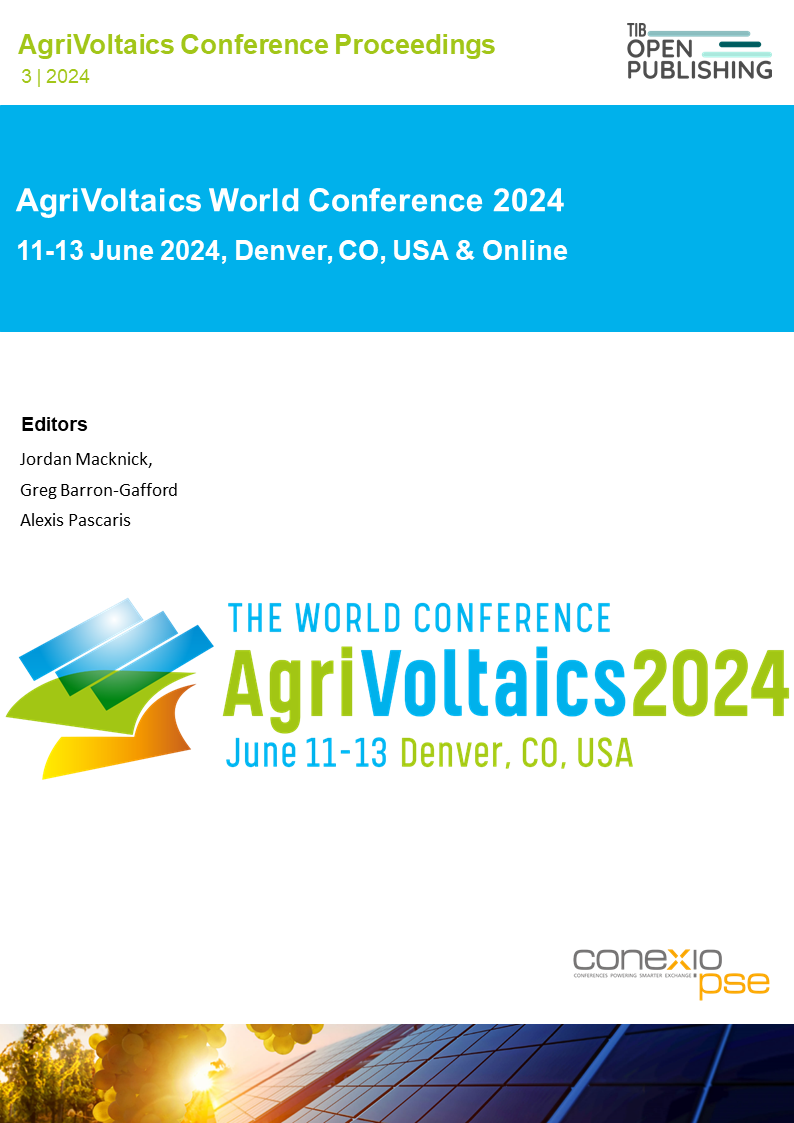The Impact of Photovoltaic on Permanent Grassland Composition and Productivity in Central Italy
DOI:
https://doi.org/10.52825/agripv.v3i.1372Keywords:
Agrivoltaics System, Grassland, Renewable EnergyAbstract
Climate change and population growth put a strain on energy and food resources, prompting a shift to renewable energy. The EU is aiming for 40 per cent renewable energy by 2030 and photovoltaic solar systems are expected as the primary source of electricity by 2035. However, the expansion of photovoltaics generates conflicts over land use, especially in agriculture. Agrivoltaic (AV) systems, which integrate photovoltaic panels with agricultural practices, offer a promising solution by providing crops with partial shade, thus potentially mitigating excessive sunlight and reducing water stress. This study evaluates the effects of an AV system on a 70 ha pasture in Ravenna, Italy, examining changes in pasture composition and productivity. In order to identify variations along the shadow gradient, four sampling areas were chosen along the transect perpendicular to the panel row, where plant species were identified and crop biomass sampled throughout the growing season in 2023. The results revealed a dominant presence of Grasses, with percentages of Leguminous ranging from 20 to 40% in less shaded areas, and other species present mainly in shaded areas, particularly in the back edge of the panel. Biomass yield showed considerable variation along the transect, with higher yields near the panels and lower below the central panels. The biomass peaks highlight the role of shading, sunlight and water drainage in production. These results emphasize the critical influence of shading in AV systems, providing insights for optimizing pasture management and crop selection to increase productivity under different light conditions.
Downloads
References
International Energy Agency (2023), World Energy Outlook 2023, IEA,
C. Dupraz, H. Marrou, G. Talbot, L. Dufour, A. Nogier, and Y. Ferard, “Combining solar photovoltaic panels and food crops for optimising land use: Towards new agrivoltaic schemes,” Renew. Energy, vol. 36, no. 10, pp. 2725–2732, Oct. 2011, doi: https://doi.org/10.1016/j.renene.2011.03.005
H. Marrou, L. Guilioni, L. Dufour, C. Dupraz, and J. Wéry, “Microclimate under agrivoltaic systems: Is crop growth rate affected in the partial shade of solar panels?,” Agric. Forest Meteorol., vol. 177, pp. 117–132, Apr. 2013, doi: https://doi.org/10.1016/j.agrformet.2013.04.012
Ministry of Ecological Transition, “Guidelines on Agrivoltaic Installations, Italy,” 2022.
T. Reher et al., “Potential of sugar beet (Beta vulgaris) and wheat (Triticum aestivum) production in vertical bifacial, tracked, or elevated agrivoltaic systems in Belgium,” Appl. Energy, vol. 359, p. 122679, 2024, doi: https://doi.org/10.1016/J.APENERGY.2024.122679
S. Touil, A. Richa, M. Fizir, and B. Bingwa, “Shading effect of photovoltaic panels on horticulture crops production: A mini review,” Rev. Environ. Sci. Bio/Technol., vol. 20, no. 2, pp. 281–296, 2021. DOI: https://doi.org/10.1007/s11157-021-09572-2
Laub, M., Pataczek, L., Feuerbacher, A. et al. Contrasting yield responses at varying levels of shade suggest different suitability of crops for dual land-use systems: a meta-analysis. Agron. Sustain. Dev. 42, 51 (2022). https://doi.org/10.1007/s13593-022-00783-7
C. Dupraz, “Assessment of the ground coverage ratio of agrivoltaic systems as a proxy for potential crop productivity,” Agrofor. Syst., vol. 98, pp. 2679–2696, 2024, doi: https.doi.org/10.1007/s10457-023-00906-3
Andrew, A. C., Higgins, C. W., Smallman, M. A., Prado-Tarango, D. E., Rosati, A., Ghajar, S., Graham, M., & Ates, S. (2024). Herbage and sheep production from simple, diverse, and legume pastures established in an agrivoltaic production system. Grass and Forage Science, 79(2), 294–307. doi: https.doi.org/10.1111/gfs.12653
S. Edouard, D. Combes, M. Van Iseghem, M. Ng Wing Tin, and A. J. Escobar-Gutiérrez, “Increasing land productivity with agriphotovoltaics: Application to an alfalfa field,” Appl. Energy, vol. 329, no. 120207, Jan. 2023, doi: https.doi.org/10.1016/j.apenergy.2022.120207
J. Madej, L. Loan, C. Picon-Cochard, C. l'Ecluse, C. Cogny, L. Michaud, M. Roncoroni, and D. Colosse, “One Year of Grassland Vegetation Dynamics in Two Sheep-Grazed Agrivoltaic Systems,” AgriVoltaics Conf. Proc., vol. 1, no. 1, Jan. 2024, doi: https.doi.org/10.52825/agripv.v1i.692
Published
How to Cite
Conference Proceedings Volume
Section
License
Copyright (c) 2025 Michele Moretta, Riccardo Rossi, Gloria Padovan, Nicolina Staglianò, Enrico Palchetti, Marco Bindi, Pietro Elia Campana, Marco Moriondo

This work is licensed under a Creative Commons Attribution 4.0 International License.
Accepted 2025-01-27
Published 2025-03-26
